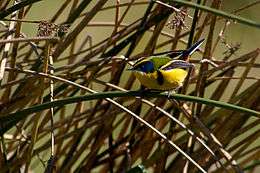Many-colored rush tyrant
| Many-colored rush tyrant | |
|---|---|
 | |
| Scientific classification | |
| Kingdom: | Animalia |
| Phylum: | Chordata |
| Class: | Aves |
| Order: | Passeriformes |
| Family: | Tyrannidae |
| Genus: | Tachuris Lafresnaye, 1836 |
| Species: | T. rubrigastra |
| Binomial name | |
| Tachuris rubrigastra (Vieillot, 1817) | |
The many-colored rush tyrant (Tachuris rubrigastra) or many-coloured rush tyrant is a small passerine bird of South America belonging to the tyrant flycatcher family. It is the only member of the genus Tachuris and its relationships with the other members of the family are uncertain, and it may constitute a separate monotypic family. It inhabits marshland and reedbeds around lakes and rivers. It is particularly associated with stands of Scirpus. The nest is built among plant stems.[2]
Taxonomy and systematics
A 2013 DNA study of South American suboscines suggested that this species does not belong in the tyrant-flycatcher family but is a monotypic family, separated from other suboscines for at least 25 million years. They proposed the family name Tachurididae,[3] although it has also been suggested that the name should be Tachurisidae.[4] This elevation to family hasn't been adopted by any authorities yet, however, pending further research.[5]
There are four subspecies: T. r. rubrigastra is the most widespread, occurring from south-east Brazil to southern Argentina and central Chile. T. r. alticola is found in the Andes of south-east Peru, west Bolivia and north-west Argentina. T. r. libertatis is found in coastal Peru while T. r. loaensis is restricted to Antofagasta Region in northern Chile.
Description
It is a small bird, 10.5 cm in length. The tail is short, the wings are short and rounded and the bill is slender. As the bird's name suggests, the plumage is very colourful. The back and rump are green while the underparts are yellow apart from the white throat, black breastband and red undertail-coverts. The face is dark blue-grey, there is a yellow stripe over the eye and the crown is dark with a red patch that is often concealed. The wings and tail are dark with a white wingbar and white outer tail-feathers. Juveniles are considerably duller than the adults.
References
- ↑ BirdLife International (2012). "Tachuris rubrigastra". IUCN Red List of Threatened Species. Version 2013.2. International Union for Conservation of Nature. Retrieved 26 November 2013.
- ↑ Jaramillo, Alvaro; Burke, Peter & Beadle, David (2003) Field Guide to the Birds of Chile. Christopher Helm, London.
- ↑ Ohlson, J; Irestedt, M; Ericson, P; Fjeldså, J (2013). "Phylogeny and classification of the New World suboscines (Aves, Passeriformes)". Zootaxa. 3613 (1): 1–35.
- ↑ Franz, I (2015). "A family-group name correction in Aves: Tachurisidae instead of Tachurididae Ohlson, Irestedt, Ericson & Fjeldså, 2013". Zootaxa. 3941 (4): 593–594. PMID 25947533.
- ↑ South American Classification Committee. "Part 8. Suboscine Passeriformes, C (Tyrannidae to Tityridae)". A Classification of the Bird Species of South America. Retrieved 28 February 2017.
External links
| Wikimedia Commons has media related to Tachuris_rubrigastra. |
| Wikispecies has information related to Tachuris_rubrigastra |
